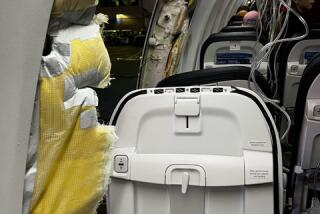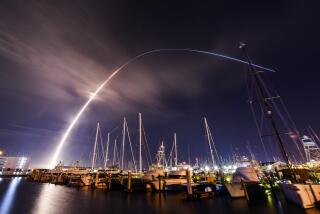Floating Into a Nightmare : Two Barely Survive 6,700-Mile Flight Across Pacific in 220-Foot Balloon
- Share via
Eight days ago, six miles above the Pacific Ocean in the world’s largest hot-air balloon, Richard Branson and Per Lindstrand were at the point of no return and confronted by a life-or-death decision.
Having accidentally jettisoned one-third of their propane fuel, they figured they could ditch in monstrous seas 900 miles north of Midway with little hope of being rescued, or they could continue on and hope to get close enough to North America to be picked up.
Japan was only a thousand miles behind them, but you don’t simply turn around and go back in a balloon. Instead, the wind was taking them into the vast wastes of the North Pacific, hanging from hot air in an eight-foot-diameter pressurized gondola, similar to a space capsule.
“Base came back to us (by radio) and basically said, ‘You’re dead people if you ditch,’ ” Branson said. “We then did some calculations and realized we had about a 5% chance of making it. We had to cross the Pacific in 30 hours from then. That meant we had to average 170 m.p.h. the rest of the way.”
That no manned hot-air balloon had ever crossed the Pacific or attained a speed of 170 m.p.h. doesn’t matter when it is the only chance. They took it and, riding a jet stream at speeds reaching 218 m.p.h., the next day they slammed back to earth on an unnamed frozen lake deep in Canada’s Northwest Territories. It was the longest manned balloon flight ever--helium or hot air--6,700 miles in 46 hours 16 minutes, at an average speed of 145 m.p.h.
They didn’t plan to land that far north, but that’s ballooning.
Branson, 40, is the founding chairman of Britain’s Virgin Atlantic Airways, Virgin Records and the Virgin group of worldwide entertainment companies.
Lindstrand, 42 and Swedish by birth, makes hot-air balloons at a factory in Wales. The last one he made was a beauty: Pacific Flyer, which at 220 feet was 69 feet taller than the Statue of Liberty and, with a capacity of 2.6 million cubic feet, 30 times larger than the average balloon.
In 1987, Branson and Lindstrand astounded balloonists by flying the smaller Atlantic Flyer from Maine to a crash-landing in Ireland, a hot-air baloon record of 3,075 miles.
“It was always considered that a hot-air balloon could never, ever dream of going more than a thousand miles,” Branson said.
Let alone approach the transpacific record of 5,500 miles set in 1981 by Rocky Aoki and three companions, who flew from Japan to Covello, Calif., in a helium balloon.
In the last year of World War II, about 1,000 small, unmanned balloons reached the Pacific Northwest from Japan, bearing anti-personnel or incendiary bombs with the idea of causing panic and starting forest fires. Six picnickers were reported killed by a balloon bomb near Bly, Ore., but otherwise they caused no significant damage.
Lindstrand said, “That was probably the first time the jet stream had been utilized and charted for a purpose. At that time aircraft didn’t go high enough to be affected.”
Lindstrand and Branson acknowledged, however, that their Atlantic success lulled them into a sense of overconfidence that nearly cost them their lives.
Lindstrand said, “The ultimate flight became the ultimate fright.”
The predawn lift-off was from Miyakonojo near Japan’s southern tip on Wednesday, Jan. 16. On this side of the international date line, it was 10:47 a.m. PST Tuesday, Jan. 15. Branson and Lindstrand were aware of the significance of the timing.
“We knew the (Persian Gulf War) deadline was there,” Branson said. “But we’d been waiting a while, and we’d postponed it a year earlier and again in December. Somehow, we felt if we could get away before the war broke out it was OK.”
Lindstrand said, “It was the first day of the entire winter season that we had (the right) jet stream. The last thing on earth you want to allow is Saddam (Hussein) to mess you up.”
Nor were they daunted by the death two days earlier of a Japanese, Fumio Niwa, who hoped to fly a helium balloon to San Diego. He crashed 400 miles offshore and died overnight of exposure while awaiting rescue.
So they went. The war started the next day, but by then the fliers had their own problems. Branson’s first entry in his log:
“Omega (navigational system) not working. (Pressuring) engine smoking. Fuel gauge not working.” The jet streams are literally wide, shallow streams of wind in the substratosphere, often no more than 500 feet deep. Although they generally blow from west to east, they are unreliable and not always predictable, and flying a 220-foot-tall balloon in one is tricky.
Branson said, “Holding it inside (vertically) was really a struggle. You had to work the burner, hand-flying all the time, every single second.”
Lindstrand said, “It’s like driving a car on an icy road too fast for 24 hours.”
A thousand miles out, Lindstrand hit a switch to fire explosive bolts and jettison the first used propane tank. Instead, two others also fell off.
Suddenly losing three tons of ballast from one side, the capsule lurched to a severe tilt as the balloon shot upward, with the remaining three fuel tanks hanging out precariously from the other side.
“Three (propane tanks) gone. Capsule at massive tilt. Remaining fuel tanks dislodged. Could go anytime. Landing mid-Pacific looks likely. Seas very rough.”
They flew on, discussing what to do.
“The incredible thing about the balloon that Per built was we literally solar-flew,” Branson said--meaning that the heat of the sun on the balloon’s metallic fabric was enough to provide lift, without using the burners.
“We didn’t use any fuel at all in the daytime. In fact, the frightening thing sometimes was trying to stop the balloon from going up. We had to open up the parachute (valve) in the top of the balloon in order to stop it from going off into space.”
“Very very tired. Per asleep. Flying through the night to God knows where.” The violent storms below had not diminished. Their rescue coordinator, Doc Wiley, told them that any ships in the area were having difficulty saving themselves in the 60-foot seas.
“Your only chance is to plunge on,” he said.
“Coming near (international) dateline. As far away from help as anyone can be. Terrified . . . . Per inclined to ditch while in touch with Honolulu rescue. I’m for pushing on.”
On the second night, as Branson slept, Lindstrand was flying the balloon, looking up through the plastic bubble at the burners, his hands on the overhead controls.
“There’s someone outside the window looking in,” he thought.
He knew then he was tired.
Later, their roles were reversed when Branson noticed balls of flame above him. He kicked Lindstrand awake.
“Don’t be stupid,” Lindstrand said. “Nothing will burn up here.”
It was 50 degrees below zero outside. Propane, which liquefies at minus-47, had formed little snowballs that ignited from the burner and were dripping onto the plastic canopy.
“Since we were pressurized, if that had ruptured the plastic, we would have just popped straight out in a very nasty ascent,” Branson said.
They solved the problem by switching to another burner. Then they started plotting a place to ditch off the West Coast.
“Things look pretty desperate. I’m not certain that this notebook will get home.”
Bob Rice, a National Weather Service meteorologist who was monitoring the flight, advised them to drop to 10,000 feet to pick up a polar jet stream or they would be sucked southward by a tropical jet stream and back toward Hawaii. So they flew north over Sitka, Alaska, and then eastward into the Territories to await daylight and look for a landing spot.
“We didn’t have any maps of that area because we didn’t expect to be there,” Branson said.
“Just been told that war has broken out.”
All they could see was snow and trees.
Branson said, “We had to land early in the morning, because the solar heating would have been so powerful we wouldn’t have come down until night.”
That would have placed them over Greenland or the Arctic with the prospect of freezing before help arrived.
“We had to get it down,” Branson said. “All of a sudden out of the trees we saw a lake ahead and decided to go for it. This was our last chance. . . . (We) hit it pretty hard. The fact we’d flown farther than any balloon before seemed rather unimportant. We were glad to be alive.”
There was one witness to their landing.
Waiting for a helicopter to collect them 4 1/2 hours later, Branson made his final entry:
“Pacific Flyer has landed.”
Times researcher Joyce Sherwood contributed to this story.
More to Read
Sign up for The Wild
We’ll help you find the best places to hike, bike and run, as well as the perfect silent spots for meditation and yoga.
You may occasionally receive promotional content from the Los Angeles Times.






